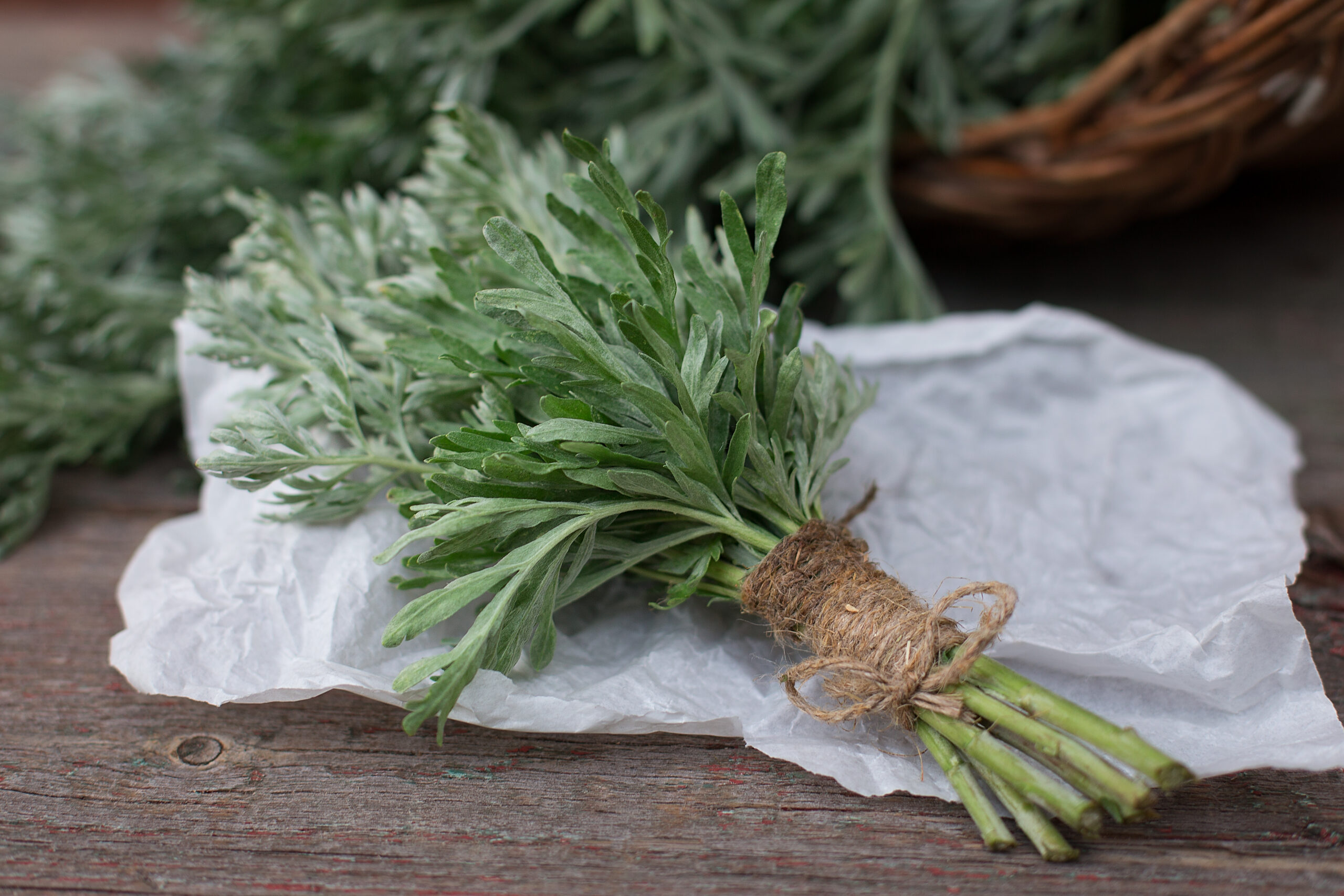
by Christine Iverson
There’s a definite chill in the air and the days are noticeably shorter as we head towards autumn and the festival of Samhain. Our ancestors considered many herbs and plants as capable of providing protection from demons and witches who were believed to be most active during the darker days.
Mugwort
Also known as cronewort or the witches herb, mugwort would be planted in the garden or hung in the doorway of the local wise woman, healer, witch or cunning man. Mugwort was often used in divination with an infusion being used to cleanse crystal balls and scrying mirrors. Burning incense made from mugwort and sandalwood could also be used to aid concentration and enhance psychic powers.
Mugwort appears in many ancient recipes for ‘flying ointments’ these hallucinogenic potions, when applied to the skin, could take the user into a trance like state or journey. Mugwort tea, although very bitter, is believed to induce prophetic dreams and can also be placed under the pillow for vivid and intuitive dreams.
Bunches of mugwort were hung in doorways to protect against evil entering the home. In Germany people wore head dresses of mugwort and vervain whilst gazing into a bonfire through bunches of larkspur to keep their eyes healthy for another year. As they left the fireside they threw their head dresses into the fire saying:
‘May all my ill luck depart and be burnt up with these.’
Yarrow
Yarrow tea was used by witches to enhance their psychic powers and holding the plant up to the eyes is said to give the power of second sight. Folklore tells us that yarrow’s delicate white flowers help with the summoning and communication with spirits and in divination.
Unmarried maidens in Sussex would pick yarrow from a young man’s grave by the light of the full moon and put it under their pillow saying:
‘Good night fair yarrow,
Thrice goodnight to thee,
I hope before tomorrow,
My true love to see.’
Often known as seven year’s love, yarrow was included in bridal bouquets, hung over the marriage bed and often eaten at wedding breakfasts to ensure that the couple were happy for at least seven years.
Before going on a journey pull out 10 stalks of yarrow, keep nine and throw the tenth away as an offering to the spirits. Place the nine stalks under your right heel and you will be protected from any malevolent spirits on your journey.
Mistletoe
To ward off demons twigs of mistletoe were hung in bundles over a door. In some countries sprigs were placed in the stable to keep livestock safe from local witches. In England and Wales farmers gave a bunch of mistletoe to the first cow that calved to ensure the health and milk production of the whole herd for the year.
In Scotland a sprig of mistletoe was cut at Samhain with a new knife from the Errol oak by a member of the Hay family, having circled the tree three times sunwise whilst chanting a secret spell this would ensure that the family would have protection from witches and injury whilst in battle.
Mistletoe was considered sacred by the Druids and other pagan religions, especially if it was growing on their hallowed tree the oak. The most powerful magic wands were made from oak that had mistletoe growing on it.
The Druids cut mistletoe using a golden sickle on the sixth night of the new moon after the winter solstice. It was not allowed to touch the ground or it would lose its magical powers hence it was caught in a cloak. The chief Druid would then divide the branches into many sprigs and distribute them to the people, who hung them over doorways as protection against thunder, lightning and other evils.
Elder
An Elder tree that has seeded itself in your garden is said to prevent evil spirits, negative influences and lightening from entering the home.
Elders were believed to be inhabited by witches who had transformed themselves into the tree in order to escape capture. You must always ask permission from the resident witch before you forage from her tree or suffer the consequences.
You risk becoming bewitched if you burn an Elder tree in your hearth, the devil will be sitting on the chimney waiting for an opportunity to come in.
‘Elder is the lady’s tree,
Burn it not or cursed you’ll be’
Folklore tells us to bathe our eyes with green elder juice in order to be able to see fairies and witches (not recommended!) Elder branches should never be taken into the house especially at Samhain or bad luck is sure to follow, however crosses made from elder hung outside the front door will provide protection and prevent evil entities from entering.

About the author:
Christine Iverson is the bestselling author of The Hedgerow Apothecary and other foraging books. She runs regular folklore and foraging workshops at Tuppenny Barn Organics and gives talks to local women’s institutes and horticultural societies. Her latest work, The Herbal Apothecary is a beautiful photographic book in which you will discover the fascinating properties and therapeutic benefits of everyday ingredients found in herb gardens and kitchen cupboards. Drawing on the work of herbalists and healers from the past, Christine guides us through the different ways we can use herbs and spices to create salves, toddies, teas, balms and preserves as cures for common ailments and to add piquant aromas and flavours to dishes.
The Herbal Apothecary: Recipes, Remedies and Rituals is published by Summersdale Publishers, and you can purchase it for £14.99 here.
 by Christine Iverson
There’s a definite chill in the air and the days are noticeably shorter as we head towards autumn and the festival of Samhain. Our ancestors considered many herbs and plants as capable of providing protection from demons and witches who were believed to be most active during the darker days.
by Christine Iverson
There’s a definite chill in the air and the days are noticeably shorter as we head towards autumn and the festival of Samhain. Our ancestors considered many herbs and plants as capable of providing protection from demons and witches who were believed to be most active during the darker days.



